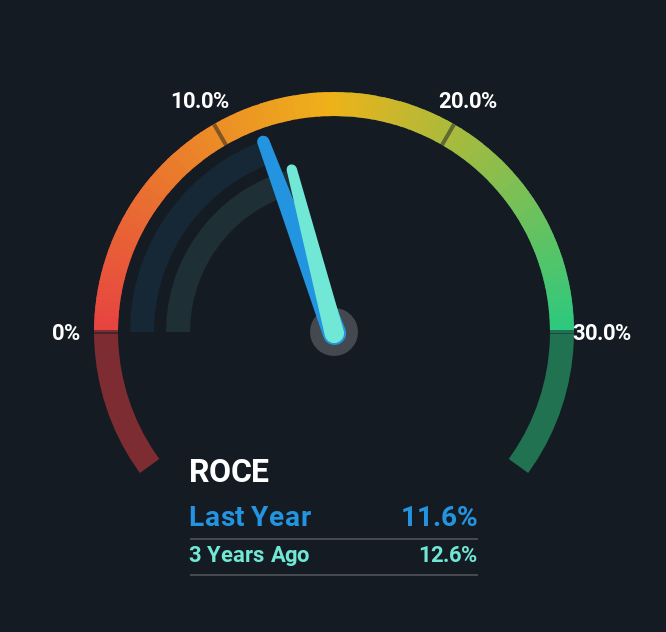- United States
- /
- Interactive Media and Services
- /
- NasdaqGS:MOMO
Be Wary Of Hello Group (NASDAQ:MOMO) And Its Returns On Capital
What financial metrics can indicate to us that a company is maturing or even in decline? When we see a declining return on capital employed (ROCE) in conjunction with a declining base of capital employed, that's often how a mature business shows signs of aging. This reveals that the company isn't compounding shareholder wealth because returns are falling and its net asset base is shrinking. In light of that, from a first glance at Hello Group (NASDAQ:MOMO), we've spotted some signs that it could be struggling, so let's investigate.
What Is Return On Capital Employed (ROCE)?
For those who don't know, ROCE is a measure of a company's yearly pre-tax profit (its return), relative to the capital employed in the business. The formula for this calculation on Hello Group is:
Return on Capital Employed = Earnings Before Interest and Tax (EBIT) ÷ (Total Assets - Current Liabilities)
0.12 = CN¥1.4b ÷ (CN¥17b - CN¥4.9b) (Based on the trailing twelve months to March 2025).
Thus, Hello Group has an ROCE of 12%. In absolute terms, that's a satisfactory return, but compared to the Interactive Media and Services industry average of 5.4% it's much better.
Check out our latest analysis for Hello Group

Above you can see how the current ROCE for Hello Group compares to its prior returns on capital, but there's only so much you can tell from the past. If you're interested, you can view the analysts predictions in our free analyst report for Hello Group .
What Does the ROCE Trend For Hello Group Tell Us?
The trend of returns that Hello Group is generating are raising some concerns. Unfortunately, returns have declined substantially over the last five years to the 12% we see today. In addition to that, Hello Group is now employing 40% less capital than it was five years ago. The fact that both are shrinking is an indication that the business is going through some tough times. If these underlying trends continue, we wouldn't be too optimistic going forward.
While on the subject, we noticed that the ratio of current liabilities to total assets has risen to 29%, which has impacted the ROCE. Without this increase, it's likely that ROCE would be even lower than 12%. Keep an eye on this ratio, because the business could encounter some new risks if this metric gets too high.
The Bottom Line On Hello Group's ROCE
To see Hello Group reducing the capital employed in the business in tandem with diminishing returns, is concerning. It should come as no surprise then that the stock has fallen 33% over the last five years, so it looks like investors are recognizing these changes. Unless there is a shift to a more positive trajectory in these metrics, we would look elsewhere.
Since virtually every company faces some risks, it's worth knowing what they are, and we've spotted 2 warning signs for Hello Group (of which 1 is potentially serious!) that you should know about.
If you want to search for solid companies with great earnings, check out this free list of companies with good balance sheets and impressive returns on equity.
Valuation is complex, but we're here to simplify it.
Discover if Hello Group might be undervalued or overvalued with our detailed analysis, featuring fair value estimates, potential risks, dividends, insider trades, and its financial condition.
Access Free AnalysisHave feedback on this article? Concerned about the content? Get in touch with us directly. Alternatively, email editorial-team (at) simplywallst.com.
This article by Simply Wall St is general in nature. We provide commentary based on historical data and analyst forecasts only using an unbiased methodology and our articles are not intended to be financial advice. It does not constitute a recommendation to buy or sell any stock, and does not take account of your objectives, or your financial situation. We aim to bring you long-term focused analysis driven by fundamental data. Note that our analysis may not factor in the latest price-sensitive company announcements or qualitative material. Simply Wall St has no position in any stocks mentioned.
About NasdaqGS:MOMO
Hello Group
Provides mobile-based social and entertainment services in the People’s Republic of China and internationally.
Flawless balance sheet and undervalued.
Similar Companies
Market Insights
Community Narratives



